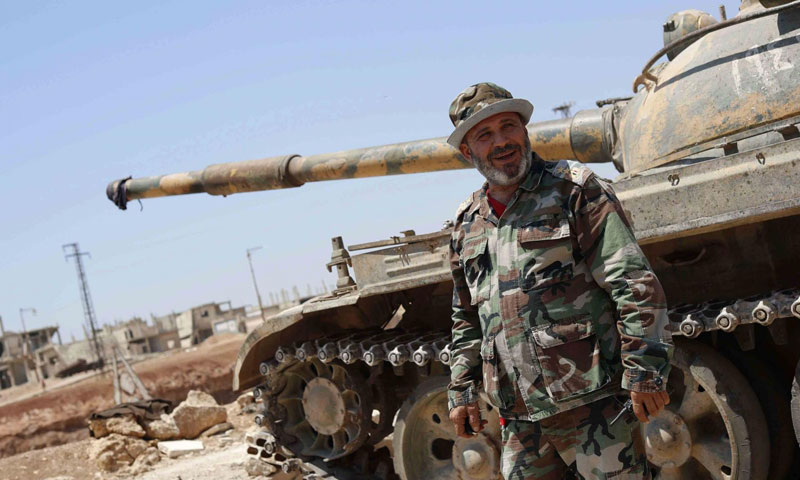A month and a half have passed since the “Sochi” deal concerning Idlib governorate, and while the opposition factions held to its defined terms of the withdrawal of heavy weaponry from the buffer zone and the removal of the “hardliner” groups, the Assad’s forces persisted on bombarding the areas, along the separation line and moved not any of its heavy arms.
In sync with the artillery and missile shelling, which led to the death of nine civilians, the last of whom are six from the al-Rafah village, southern Idlib, who died on October 26, the political statements of the Syrian regime kept stressing the idea of Idlib governorate’s return to “the bosom of the Syrian state after expelling the terrorists from it,” according to the official narrative’s description.
In his last statement, the Syrian Minister of Foreign Affairs, Walid Muallem, said that the Syrian regime “prefers a peaceful solution for the Syrian affair. The armed groups in Idlib came through Turkey, and it is natural for them to return through the same way.”
The former actions on the part of the Syrian regime have two indications; the first is on the ground, manifested by the “provocative” shelling, through which the Assad’s forces are testing the opposition factions about the heavy weaponry. The second is the political statements, which propose the Syrian regime’s refusal of the deal, the signing of which by Turkey and Russia was a “big slap” after military enhancements were deployed as to start a battle in the area.
How Far Has the Deal Progressed?
In the latest Turkish statements about the “Sochi” deal, the Turkish President Recep Tayyip Erdoğan said that his country observed no problems in Idlib governorate since the deal was signed with the Russian side.
He added, in a speech quoted by the “Anadolu Agency,” on October26, “we have not observed any problem in Idlib since the Sochi deal was signed, for the area is witnessing stability and calm.”
The “Free Army” factions, two weeks following signing the deal, announced the complete removal of heavy weaponry from the buffer zone. However, they pointed out that their military posts still exist in the area.
In addition to the “Free Army,” represented by the “National Front for Liberation,” the “Tahrir al-Sham,” has withdrew its arms, but indirectly, which corresponded to a statement issued by it, in which it approved the deal implicitly, without an open declaration.
Concerning the “hardliners,” a massive number of them have retreated from the buffer zone, according to the Turkish Minister of Defense Hulusi Akar, who said that the violation of the ceasefire has declined with about 90%.
A leader of the “Free Army” told Enab Baladi that the upcoming phase of the deal relates to launching Turkish-Russian patrols in the buffer zone, pointing out that the patrols are decided to start early in November.
Nonetheless, the leader explained to Enab Baladi that launching the patrols, though has been signed a date, lacks the mechanisms which have not yet been set, especially with the opposition factions’ refusal of the Russian police’s entry to their areas, while demanding a Turkish presence alone.
The mechanism is supposed to clarify after the periodic meetings held by the Russian and Turkish officials, the last of which was the quadrilateral summit at the Turkish city of Istanbul.
The leader of the “Free Army” does not exclude the signing of a deal as to spread western forces, the task of which is to separate between the Syrian regime and the opposition in Idlib, to arrive at a moderate solution that satisfy the opposition factions, which have lately approved the borders of the buffer zone throughout their areas.
Provocation, which the Opposition Answers
In the past a few days, the Assad’s forces shelling targeted not only Idlib’s fronts, but it covered areas extending from the western rural Hama to the western rural Aleppo, passing through the northern rural parts of Hama and the southern parts of Idlib.
The Assad’s forces have justified the bombardment by saying that the opposition factions initiated the action, particularly with heavy weaponry from the buffer zone, agreed to be completely emptied of these arms.
In correspondence with the constant shelling of Idlib, the “al-Watan” newspaper, close to the Syrian regime, said that the Assad’s forces have set up a map of the opposition factions’ presence in the buffer zone, agreed upon by Russia and Turkey.
It reported that the “hardliner” factions have again spread in the area and that the Assad’s forces have identified the positions where heavy weaponry, including tanks and artillery, are positioned.
For their part, the factions did not keep silent, for they have responded to the attacks, the majority of which targeted residential neighbors.
In addition to this, they paraded the military batches that are graduating from their camps, the last of which graduated on October 25, for the “National Front,” has declared a military training at the “Martyr Leader Riyad Qarah Bajaq” camp.
The leader of the “Free Army” considers that the graduation of the military batches on the part of the factions is a gesture representing the constant readiness to combat any military operation on the part of the Syrian regime, saying: “To the day, the Syrian regime and the opposition have not completely approved the deal despite the agreement between Russia and Turkey.”
On October 27, the “Tahrir al-Sham” has also announced military maneuvers in southern rural Idlib, in a first of its kind step after its implicit approval of the deal.
On its official platforms, the “Tahrir al-Sham” has posted footage of the maneuvers, conducted by its affiliate “Al-Nukhbah Forces” (Elite Forces), which utilized all types of heavy and light weapons, in addition to sniper rifles.
The faction did not mention the specific location where the maneuvers were conducted, whether in the demilitarized area or outside it, deep in Idlib governorate.

